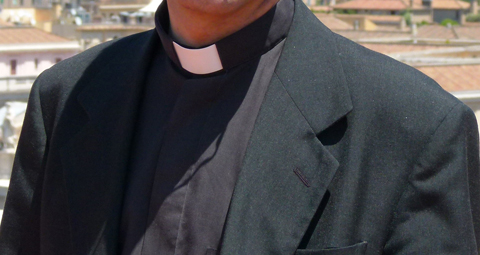BY James Farrell | February 8 | ![]() 0 COMMENTS
0 COMMENTS ![]() print
print

A priest’s collar is not a sign of power or privilege, but one of availability, service and love.
Fr McMorrin reflects on the clothing of clergy, and how it reminds him always to be an ambassador for Christ
Recently, I made a trip to Ikea with our parish Sister to purchase some kitchen supplies for the parish hall. Sister happens to come from Sweden, and so she was rather more excited about the prospect of making a patriotic pilgrimage to her nation’s most famous Scottish outpost than I was. For me, a morning spent among mass-produced furniture was a rather tedious duty, only slightly relieved by the prospect of spicy meatballs for lunch.
Nonetheless, the sight of a young nun in her early twenties, complete with veil and long habit, comparing the prices of mugs and tea-spoons with a young-ish priest in a clerical collar, caused quite a stir among our fellow shoppers.
No-one engaged us in any in-depth conversation on matters of Faith; no-one asked to go to confession in the kitchen-ware aisle; no-one, I’m fairly sure, was converted to Christ that day in Ikea. But, nonetheless, our presence, in the very midst of the ordinary was, I hope, a little witness to our identities as men and women dedicated to God.
Sister is a much better witness than I am: she is unfailingly joyful, no matter the chaos the cathedral office (not to mention the cathedral clergy!) can throw at her. She often remarks about interesting conversations she’s had with commuters on her way to the office, or simply the way people smile at her when they see her walking about the streets of Edinburgh.
My own experience has been mixed: there have been plenty of funny looks, a few muttered comments and one or two direct insults. Once, in Rome, a Spanish teenager spat on me after telling me what he thought of priests—it seemed pedantic to point out to him that I was, in fact, a deacon at the time.
But these have been very rare exceptions. Generally, bemused curiosity is the most common reaction. I remember once sitting at a motorway service station with a group of priests and overhearing a passer-by pointing out to his friend, with an astonished whisper, ‘they’ve got phones!’
Other encounters have been more profound: people have often seen the clerical collar as an invitation to ask questions, or to enter into debate, or to ask for prayers. It is said by some the collar could be seen as a barrier, designed to keep people at arm’s length: perhaps this is true, but it hasn’t been my own experience. If it does exist, that pre-conception has to be broken down: letting people know—one gentle smile at a time—that the collar is not a sign of power, of judgement, or of privilege, but, rather, a sign of availability, of service and of love.
Of course, like all things, it can be abused. Clericalism is a danger against which our Lord warned in the most strident terms: broad phylacteries and long fringes were an indicator, in his day, not of humble service but of hypocritical bullying. They were used to assert status, to extract obsequious greetings and to claim special treatment. There are, perhaps, still parts of the world where the clerical collar has the same effect. Not, I can assure you, in secular Edinburgh!
For most priests, wearing clerical dress is a duty. It’s required by Canon Law, at least for the celebration of the Sacraments and pastoral work. But it’s also a great help! It makes deciding what to wear in the morning (‘black or black?’) considerably easier. It helps me to live simply and unostentatiously: wearing the same outfit two days in a row is not much of a worry when you’ve worn the same outfit almost every day for four years!
Most importantly, and strange as it might seem to say, wearing clerical dress reminds me that I’m a priest. If I’m embarrassed to go somewhere dressed as a priest, I might need to think carefully about whether I ought to be there at all.
It reminds me that I’m a representative of the Church and, although unworthy, an ambassador of Jesus Christ.
When St Paul talks about ‘putting on Christ’ (Galatians 3: 27) and ‘clothing yourselves in the Lord Jesus’ (Romans 13: 14), he’s talking about Baptism, rather than priesthood. But it’s nonetheless a helpful thought for me to think about as I get dressed, preparing myself for the tasks ahead, and praying for all the people who will see my clerical collar that day: that, through my presence in their midst, they will see the love of Jesus.
So, the next time you see a priest dressed like a priest, say hello and give him a smile. And then say a little prayer for him, that God will give him the grace to be faithful to his vocation, the strength to be true to his deepest identity and the courage to be a witness to his love, wherever he is sent. Even if that’s to Ikea!










